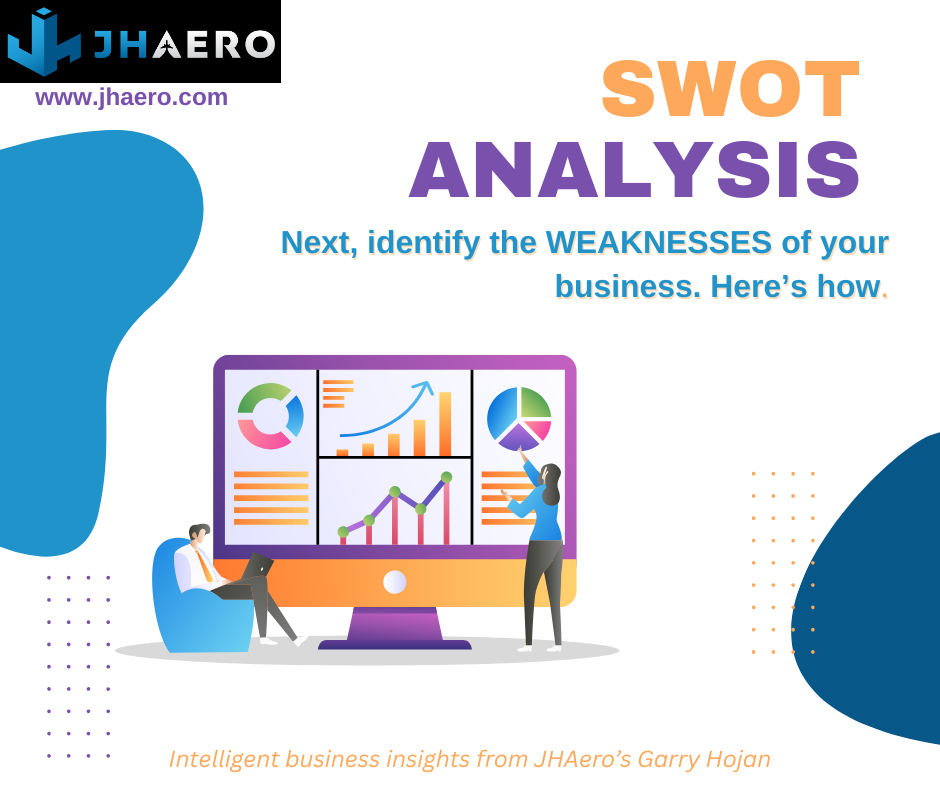By Garry Hojan
In the last newsletter, we covered the initial steps needed to begin your SWOT analysis and then began analyzing Strengths. If you missed it, you can read it here: http://bit.ly/3SIV0k2.
This newsletter will briefly cover how to evaluate and capitalize on weaknesses.
What is the purpose of analyzing weaknesses? To improve your business’s performance and strategic planning. That’s nice jargon, but what does it mean?
In the last steps, the data collection and processing team will use the same stakeholders to help you identify your business weaknesses. Let’s say we get feedback from a customer who says, “I bought from you, and I never heard from you again until your sales rep wanted another order. It’s not a big problem; I just felt like I was being used and my business didn’t matter.”
When collecting data, it’s good to acknowledge any feedback, especially negative feedback, like in this case, “Wow, I am sorry that you experienced that, and I appreciate you being open enough to be candid on how interacting with us impacted you. It’s so opposite of how we want our customers to feel, and it hurts me to think we contributed to that experience you had.”
Let them air their experience more if needed. Listening further is important, and it can also reveal more details to help you strengthen your relationships and improve your business.
In short, let’s say you collect data from customers and find that they indicate, through different experiences, that doing business with you is more transactional and less relational.
Transactional businesses have their place, usually providing short-term income with low loyalty rates. Still, many studies show that businesses operating on a relational foundation make more profit over a longer period of time and have high customer loyalty. If you are a relational person by nature, you probably already sense this.
According to HubSpot, “companies that prioritize relationship marketing make 60% more profit over time through customer loyalty.”
In our case above, where the customer felt transactional about doing business with you, we first want to look at the data and analyze whether the issue is real or can be validated. One customer, that’s going to happen, guaranteed. But when you start homing in on this and find that you have groups of customers with a similar feeling, plain and simple, it’s hurting your long-term profitability.
In this very specific case, the customer felt alienated because the only contact was to ask for more business. Some feel that you are taking from them instead of continuing to understand them and how to solve their problems. Some customers, i.e., buyers, are used to this, and it doesn’t necessarily bother them. Having said that, we could just add procedures that follow up with customers without asking for more business at that time.
Practically, we take the one call asking for business and make two calls, one to say, “Hi (name), no sales call today. I just really wanted to tell you how much I appreciate you allowing us to do business with you.” (Listen if needed.) I also wanted to make sure we took care of you and ask if there’s anything at all you think we could have done better for you. “Full stop! Listen…
Again, here’s what makes the difference…actually listen to them, empathize if needed, and do something if they make requests or suggestions. You won’t be able to fulfill every request or suggestion, but just trying and saying you can’t implement it for whatever reason shows you not only listened but respected their input enough to try.
This is relationship building, which is used if you want to be a more profitable relational business with a loyal customer base. You absolutely must be genuine in your business—more genuine than your competitor, more caring than your competitor, and much more relational than your competitor.
This is just one very specific example to help illustrate how the analysis works and what you could do with the data collected to improve profitability.
For some of you, it probably just sounds like common sense, but I’ve worked with companies that will sell business-to-consumer products valued at hundreds of thousands of dollars per transaction without a post-sale follow-up.
They make revenue and have many relational customers, but their profit and customer loyalty are much weaker than they could be. Their only saving grace is that they have no real competition in their space…for the moment.
The scenario here included a customer service weakness. I’ve included a list of other potential weaknesses provided by Google search for your team to use simply as a reference. It’s not all-inclusive, but hopefully, it can spark some conversations and improvement towards strengthening your business.
Potential points of business weakness to watch out for:
Poor Customer Service:
This can lead to lost customers and damage the brand’s reputation.
Lack of Innovation:
Failing to adapt to changing market conditions can result in a company falling behind competitors.
Weak Leadership:
Poor leadership can lead to low morale, high turnover, and lack of strategic direction.
Inefficient Processes:
Inefficient workflows and systems can waste resources and reduce productivity.
High Turnover:
A high turnover rate can disrupt operations, increase training costs, and damage morale.
Limited Resources:
Lack of capital or funding can hinder growth and innovation.
Negative Reputation:
A bad reputation can damage customer trust and loyalty.
Financial Instability:
Fluctuating cash flows, high debt, or poor financial management can threaten a company’s survival.
Lack of a Strategic Plan:
Without a clear strategic plan, a company may struggle to identify opportunities and achieve its goals.
Undocumented Systems/Business Processes:
This can lead to confusion, inefficiencies, and difficulty in training new employees.
Outdated Technology:
Sticking to outdated technology can make a company less competitive and efficient.
Lack of a Customer Relationship Management (CRM) System:
This can hinder the ability to effectively manage customer interactions and relationships.
Limited Visibility of Financial Data:
Lack of accurate financial data can make it difficult to make informed decisions.
Poor Sales Process:
A poorly defined or outdated sales process can lead to lost opportunities and reduced revenue.
Lack of a Strong Brand:
A weak brand image or lack of recognition can make attracting customers and building a loyal customer base difficult.
Inadequate Supply Chain:
A weak supply chain can lead to delays, shortages, and increased costs.
High-Cost Structure:
A high-cost structure can make competing with companies with lower costs difficult.
Poor Cost Efficiencies:
Inefficient use of resources and money can hurt profitability.
Tight Profit Margins:
Low profit margins can limit a company’s ability to reinvest in the business.
Weak Financial Reserves:
Insufficient financial reserves can make weathering economic downturns or unexpected expenses difficult.
Weak Profitability Levels:
A lack of profitability can make attracting investors and sustaining the business difficult.
Difficulty Delegating:
Managers who struggle to delegate tasks may become overwhelmed and unable to effectively manage their team.
Lack of Confidence:
This can lead to hesitancy in taking risks and making decisions.
Emotional Intelligence:
Low emotional intelligence can hinder effective communication and relationships, leading to conflicts and decreased productivity.
Ineffective Time Management:
Poor time management can lead to missed deadlines, decreased productivity, and stress.
Lack of Feedback:
A lack of constructive feedback can hinder employee growth and development.
Resistance to Change:
An unwillingness to adapt to change can make a company less competitive and agile.
Sensitivity to Criticism:
Being overly sensitive to criticism can hinder the ability to learn and grow.
Absence of Accountability:
A lack of individual accountability can lead to reduced efficiency and poor performance.
Conflict Avoidance:
Avoiding conflict can prevent issues from being addressed and can damage relationships.
Lack of Alignment:
A lack of alignment within the organization can lead to disengagement and reduced productivity.
I’m going to add one more, and I think it is one of the most critical weaknesses: Lack of Clarity. I am a strong proponent of crystal clarity and laser focus.
If you don’t have clarity in the foundational aspects of your business, which include core values, mission (your why and what), vision (a future state, where you’re going), and specific, clear goals to get there…the foundation is a weakness, and a small business’s very limited resources are almost certainly being wasted.
That’s it for weaknesses.
Need help setting your strategic foundation? Let’s chat.
Never any sales pressure, a no-charge initial consult, and a simple zero-risk guarantee…you receive higher value over cost, or you don’t pay.
You can email me at ghojan@jhaero.com or call my cell at 208-627-2565.


